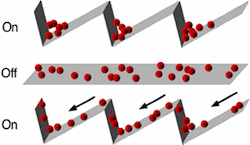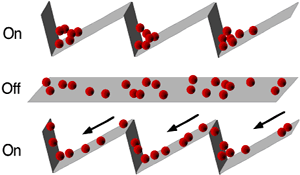Giant Diffusion on Magnetic Conveyor
Certain motor proteins move forward on a surface despite being continuously rattled by thermal fluctuations, thanks to a ratchet effect that prevents backward steps. Researchers are trying to replicate this behavior in small devices. As described in the 3 December Physical Review Letters, a magnetic ratchet that can move microscopic beads along a surface in one direction surprisingly increases random motion in the perpendicular direction in a controllable way. This technology might be used to shuttle drugs or other chemicals along a surface while also controlling the level of mixing.
A ratchet mechanism forces an otherwise randomly moving object to go in only one direction. For example, if you put small beads on a surface with a saw-tooth pattern of short ramps and vibrate it, the beads will tend to move in the downhill direction of the ramps. Another ratchet effect allows proteins like kinesin to harness random thermal energy (along with chemical energy) to move forward along a biopolymer strand in a cell. Researchers are constructing ratchets that use small localized forces to control the motion of objects such as grains, magnetic vortices, and electrons.
In 2007 Pietro Tierno, who is now at the University of Barcelona, and his colleagues created a new type of ratchet that uses magnetic fields [1]. The system moves 3-micron-diameter beads in water across a magnetized film whose surface is divided into 3.5-micron-wide stripes of distinct magnetic regions, or domains, of alternating polarity. The strength of the film’s magnetic field peaks above every wall separating two domains, and the slightly-magnetized beads are attracted to those boundaries.
To obtain the ratchet motion, the team applies an external magnetic field that varies periodically in time but not in space. This external field suppresses the bead-attractive force at every other domain wall and boosts the ones in between. When the field reverses polarity, suppressed walls become boosted walls, and vice versa, creating a magnetic “conveyor belt” that is similar to the contraction and relaxation cycle (peristalsis) that moves food through the small intestine, Tierno says.
Recently, Tierno and his colleagues were surprised to find that the frequency of the time-varying field controlled not only the speed of the particles but also the amount of diffusion in the perpendicular direction. As the beads hopped from one domain wall to the next, they spread out, or diffused, sideways. This transverse diffusion rate could be tuned to a maximum that was nearly 10,000 times greater than the diffusion without ratcheting. Such enhanced, or “giant,” diffusion has been observed previously in an optical experiment, but in that case the diffusion was in the same direction as the directed motion [2].
To explain the giant transverse diffusion, the team believes that as a bead makes a random walk sideways along a domain wall, it’s influenced by small irregularities in the film’s magnetic field. Eventually the bead gets stuck at one especially attractive spot, but the ratcheting frees it from this local “trap” and places it on a new wall with entirely different irregularities. According to this theory, the external field oscillation frequency that maximizes diffusion is the one that allows beads just enough time in each cycle to diffuse some distance along a domain wall and get stuck, but not much more time than that.
“First and foremost this is a nice piece of work on basic physics, in particular on how to control diffusion,” says Lars Egil Helseth from the University of Bergen, Norway. He says these beads are commonly used in biomedicine, so one application of this magnetic ratchet could be in drug delivery or for separation of biomolecules. “However, for this to happen the directed motion must probably be considerably faster, and the substrates must be made more available than the ferrite garnet films used here.” Heiner Linke from Lund University in Sweden thinks that insights from this work might help in processes where diffusion can be a limiting factor, such as the growing of films with epitaxy.
–Michael Schirber
Michael Schirber is a Corresponding Editor for Physics Magazine based in Lyon, France.
References
- P. Tierno, S. V. Reddy, T. H. Johansen, and T. M. Fischer, “Rupture and Healing of One-Dimensional Chains in a Parametric Magnetic Ratchet Potential,” Phys. Rev. E 75, 041404 (2007)
- S.-H. Lee and D. G. Grier, “Giant Colloidal Diffusivity on Corrugated Optical Vortices,” Phys. Rev. Lett. 96, 190601 (2006)
More Information
A Primer on Ratchets and Brownian Motors from H. Linke Brownian motor Java applet (demonstrates ratchet and also explains why it doesn’t violate thermodynamics) video explanation of kinesin motion





